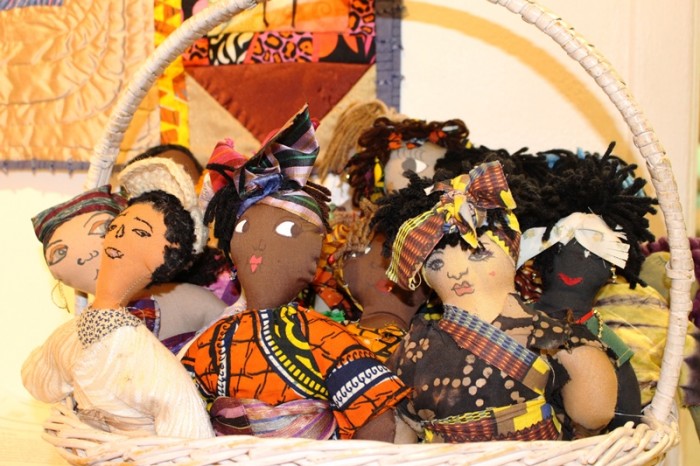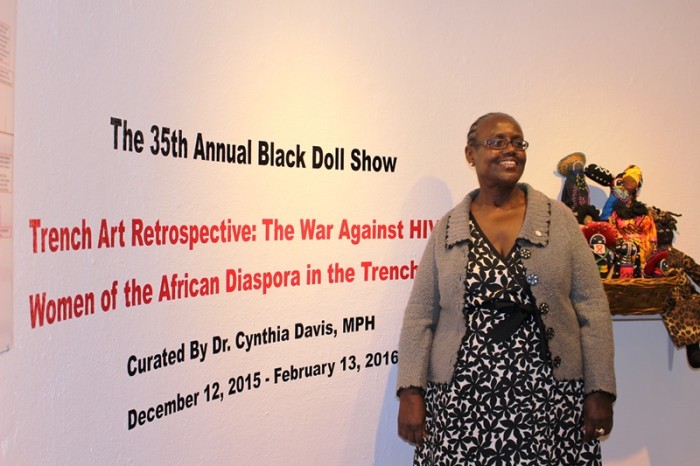
On Dec. 12th, The William Grant Still Arts Center hosted a grand opening exhibit for “Trench Art Retrospective: The War Against HIV/AIDS-Women of the African Diaspora in the Trenches”, the theme of the 35th Annual Black Doll Show currently running from Dec. 12, 2015 to Feb. 13, 2016.
Curated by Dr. Cynthia Davis, doll maker and assistant professor in the College of Medicine and College of Science and Health at Charles R. Drew University, the exhibit’s goal is to artistically depict the negative impact the HIV/AIDS pandemic continues to have on women and girls of the African Diaspora.
The exhibit features 200 colorful hand-made dolls made by some of Southern California’s top doll designers, intricate sculptures, artistically designed shrines and altars created in honor of departed loved ones as well as National Names Project Quilts that memorialize those who have passed away from AIDS.
According to statistics, African Americans comprise the largest number of HIV infections, accounting for 44 percent of all new HIV infections each year. It is estimated that 1 in 32 African American women will be diagnosed with HIV during their lifetime. In 2010, about 1 in 4 (26 percent) of all new infections were among African American youth between 13 and 24 years old.
African American men who have sex with men comprise 73 percent of new HIV infections.
Davis, who has facilitated HIV/AIDS education and risk reduction workshops targeting women and school age youth for the past 30 years, saw an urgent need to bring attention to the pandemic.
Traveling to Africa, she witnessed how HIV and AIDS have devastated the continent and was particularly touched by the thousands of orphaned children had lost their parents to AIDS. “The children had no life in their eyes,” she recalls. “They had no toys–they were playing with rocks and tree bark.”
To alleviate the suffering, Davis launched the Dolls of Hope Project. Over the past 17 years, the Dolls of Hope Project has distributed over 6,000 handmade cloth dolls to AIDS orphans, women and youth affected by HIV/AIDS throughout the world.

Davis also spearheaded the Charles Drew University HIV Community Outreach and Mobile Testing Project, which provides HIV and AIDS testing in underserved communities throughout Los Angeles.
“People can get their testing results in 20 minutes with an oral swab,” she pointed out.
Davis hoped that the HIV/AIDS epidemic at the 35th Annual Doll Show would help to dispel myths and to bring about an understanding of the disease. “The stigma against HIV and AIDS is still so prevalent in our community,” she said. “People are still fearful of being in the same room, shaking hands or even hugging people with HIV and AIDS. So many people with the infection are living in silence, isolation and fear. I think that if we can mobilize all of the institutions in our community, we can get rid of the stigma. We have to talk about it the epidemic and be non-judgmental as a community.”
The panel discussion also featured a number of women who openly discussed their HIV and AIDS status. With the medical advances currently available, all of the women, some with children born after they were diagnosed, said they are living normal lives.
Hydeia Broadbent, an international HIV/AIDS activist who was diagnosed with HIV at the age of three, hoped that the retrospective would generate a discussion about HIV and AIDS in the community. “I hope it brings awareness and helps to provide information so that people can take that information back to their families and discuss it,” she said.
Artist and doll maker Ingrid Humphrey, a member of the Dolls of Hope Project who makes her dolls out of batik African fabrics, brown muslin and colored chalk, was honored to be included in the doll exhibit. “It’s amazing how the doll exhibit has grown and how it has touched people’s lives,” she said.
Artist Ramsess, whose colorful and intricate quilts drew crowds at the exhibit, said, “I think the exhibit will enhance people’s understanding of the disease and I think the people who come to the show will leave with a lot more information that they came with.”
Stormyweather Banks, an artist and a high school teacher at the Santee Educational Project, invited some of her students to the exhibit. “These young girls think that HIV and AIDS can’t happen to them. We need to start educating our youth about HIV and AIDS at a young age so that they can be informed.”

Shine, a female drum and dance troupe, enthralled the crowd with their spirited dancing, followed by puppeteer Gary Jones of the Blackstreet USA Puppet Theatre, who delighted attendees with his skillful puppetry.
Other artists featured in the exhibit include Allyson Allen, Floyd Bell, Ofelia Esparza, Bernard Stanley Hoyes, Mary Kimbrough, and Joey Terrill.






